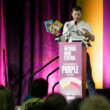Float
(Book)
JP MIYAR
2 available
JP MIYAR
1 available
Copies
| Location | Call Number | Status |
|---|---|---|
| Central - Kids Picture Books | JP MIYAR | Available |
| Central - Kids Picture Books | JP MIYAR | Available |
| Columbia Pike - Kids Picture Books | JP MIYAR | Available |
Description
More Details
Notes
Similar Titles From NoveList
Similar Authors From NoveList
Published Reviews
Booklist Review
A young fellow in a bright yellow slicker has a great play day planned despite gray skies. In fact, it's even better after a downpour creates puddles and rivers in the gutters for the newspaper boat he has made. But after his boat slides down a grate and into the blackness of the sewer, he is despondent and trudges home. After he dries off and gets back to playing, his mood is lifted by more folding. All is well when he emerges from the shadowy house into brilliant sunshine, ready to fly his new paper plane. Using exclusively wordless pages in blacks, grays, and dusty whites, with occasional splashes of sunny yellow, Miyares movingly makes the little boy's every emotion crystal clear. Miyares' use of changing perspectives and page spreads that shift from panoramic views to series of smaller panels give the story a cinematic feel. With folding instructions on the endpapers, this will likely become a repeat favorite, particularly for little ones still learning to read on their own.--McDermott, Jeanne Copyright 2015 Booklist
Publisher's Weekly Review
In the opening scene of Miyares's (Pardon Me!) wordless story, two pairs of hands-one big, one small-fold newspaper into origami boats. In the spreads that follow, a boy in a yellow slicker ventures outside and waits for a downpour to end before launching his boat, which is instantly carried away by the swiftly flowing water. It slips down a storm drain, and when the boy reaches it at last, the once-proud craft is a sodden mess. At home, his father welcomes him with a hug, then holds a blow-dryer up to the boy's wet hair. In an unexpectedly lovely moment, the boy grins widely as his hair blows sideways; readers sense his pleasure and relief. The warmth of his father's care renews the boy, and he sets off for another adventure. Skilled draftsmanship and smart pacing distinguish Miyares's visual storytelling. Seen against streets and houses of slate gray, the boy's yellow slicker is the only bright color, underlining the sense that he's in a world of his own. It's a moment of childhood captured in multiple dimensions. Ages 4-8. Agent: Studio Goodwin Sturges. (June) © Copyright PWxyz, LLC. All rights reserved.
School Library Journal Review
PreS-Gr 3-A boy clad in a bright yellow raincoat and hat graces the cover, recalling Ezra Jack Keats's A Letter to Amy (Viking, 1968). This homage to Peter's dance with an invitation has its own tale to tell, but those in the know will enjoy noticing the connections: the attire, fence, special effects with water, and paper journeys. Miyares's wordless adventure, employing panels of varying sizes, opens with a father and son forming an origami boat from a newspaper. The setting is monochromatic except for the child's clothing and significant spots of pink and blue on the newsprint. Soon after the child rushes outdoors for the launch, rain forces him to shield the boat inside his slicker. Long, gray digital strokes create an impressionistic shower around the blurry boy; clarity resumes as the storm recedes. The artist plays with aerial views and simultaneous succession, e.g., six sun-colored, puddle-jumping protagonists in one scene, until the current sweeps the boat through several pages to a sewer-fed stream. The soppy page is returned to Dad, who has hugs, cocoa, and a new idea for the next sheet of paper. This time when the door opens, sunshine floods the room and a plane is about to lift off. This warm family story models rainy-day fun and just the right amount of parental intervention. Endpapers provide directions for both forms of transportation. VERDICT The thoughtful use of color, perspective, and texture makes following this young "maker's" projects a visual pleasure.-Wendy Lukehart, District of Columbia Public Library (c) Copyright 2015. Library Journals LLC, a wholly owned subsidiary of Media Source, Inc. No redistribution permitted.
Horn Book Review
The joys, fears, and frustrations of exploration -- as well as the safety, support, and love of home -- are examined in this wordless story. Using inspiration from the newspaper, a boy and his caregiver (the only two characters in the narrative) together fold a paper boat. When the boy takes it outside to play, he pretends to sail the boat around the neighborhood. After a downpour, it floats for real -- first in a puddle and then out of the boys grasp into a sewer grate. Bereft, he returns home to find care and coziness: a loving hug, dry clothes, and a warm mug of cocoa. Soon after, our hero ventures out again into a bright yellow day, with a freshly folded paper airplane. This time, he embraces the moment when he can set his creation free. With a limited color palette of mostly grays and yellows, each scene is full of reflection, shadow, and texture. The characters are composed of distinct planes of color and appear layered, as if folded out of paper, reinforcing the tactile topic and theme. Miyaress strong command of perspective and line produces a comfortable suspense between panels and delivers a visual tale of a small moment made spectacular in the eyes of a child. Endpapers supply directions for readers to make their own paper boats and airplanes. elisa gall (c) Copyright 2015. The Horn Book, Inc., a wholly owned subsidiary of Media Source, Inc. No redistribution permitted.
Kirkus Book Review
This wordless story, bookended by the creation of two iconic paper toys, follows a Latino boy through outdoor playtime.After his father folds a boat from a sheet of newspaper with a photo of sailboats on it, the boy sets off in head-to-toe yellow raingear. He shields his boat from a downpour, then floats it in puddles that reflect the tidy neighborhood's houses and trees. After some joyous puddle-jumping, the boy sets the boat into a sluicing rivulet, pursuing it as it's swept away. When the boat slips down a grate, the dramatic perspective is from the inky dark underground, the boy futilely stretching an arm through the bars. Washed from a drainage pipe into a stream, the erstwhile boat, now a sodden sheet, is fished out by the dejected lad. He walks home to the comfort of dad's hug, dry clothes, and expertly blown-dry hair. There's shared hot cocoa and more newspaper-folding. (This time, a jet's photo appears.) Digitally rendered in grays accented in yellow, the pictures' hyper-realistic style is softened by dry-brush effects and the boy's captured emotions. The penultimate composition looks through the open doorway to the boy on the front porch. Now in shorts and T-shirt, clutching a paper airplane, he's silhouetted against a square of brilliant yellow sky. That yellow dominates the final spread, celebrating housetops, as the boy readies for his first launch. Lovely and life-affirming. (Picture book. 4-8) Copyright Kirkus Reviews, used with permission.
Booklist Reviews
A young fellow in a bright yellow slicker has a great play day planned despite gray skies. In fact, it's even better after a downpour creates puddles and rivers in the gutters for the newspaper boat he has made. But after his boat slides down a grate and into the blackness of the sewer, he is despondent and trudges home. After he dries off and gets back to playing, his mood is lifted by more folding. All is well when he emerges from the shadowy house into brilliant sunshine, ready to fly his new paper plane. Using exclusively wordless pages in blacks, grays, and dusty whites, with occasional splashes of sunny yellow, Miyares movingly makes the little boy's every emotion crystal clear. Miyares' use of changing perspectives and page spreads that shift from panoramic views to series of smaller panels give the story a cinematic feel. With folding instructions on the endpapers, this will likely become a repeat favorite, particularly for little ones still learning to read on their own. Copyright 2014 Booklist Reviews.
Publishers Weekly Reviews
In the opening scene of Miyares's (Pardon Me!) wordless story, two pairs of hands—one big, one small—fold newspaper into origami boats. In the spreads that follow, a boy in a yellow slicker ventures outside and waits for a downpour to end before launching his boat, which is instantly carried away by the swiftly flowing water. It slips down a storm drain, and when the boy reaches it at last, the once-proud craft is a sodden mess. At home, his father welcomes him with a hug, then holds a blow-dryer up to the boy's wet hair. In an unexpectedly lovely moment, the boy grins widely as his hair blows sideways; readers sense his pleasure and relief. The warmth of his father's care renews the boy, and he sets off for another adventure. Skilled draftsmanship and smart pacing distinguish Miyares's visual storytelling. Seen against streets and houses of slate gray, the boy's yellow slicker is the only bright color, underlining the sense that he's in a world of his own. It's a moment of childhood captured in multiple dimensions. Ages 4–8. Agent: Studio Goodwin Sturges. (June)
[Page ]. Copyright 2014 PWxyz LLCSchool Library Journal Reviews
PreS-Gr 3—A boy clad in a bright yellow raincoat and hat graces the cover, recalling Ezra Jack Keats's A Letter to Amy (Viking, 1968). This homage to Peter's dance with an invitation has its own tale to tell, but those in the know will enjoy noticing the connections: the attire, fence, special effects with water, and paper journeys. Miyares's wordless adventure, employing panels of varying sizes, opens with a father and son forming an origami boat from a newspaper. The setting is monochromatic except for the child's clothing and significant spots of pink and blue on the newsprint. Soon after the child rushes outdoors for the launch, rain forces him to shield the boat inside his slicker. Long, gray digital strokes create an impressionistic shower around the blurry boy; clarity resumes as the storm recedes. The artist plays with aerial views and simultaneous succession, e.g., six sun-colored, puddle-jumping protagonists in one scene, until the current sweeps the boat through several pages to a sewer-fed stream. The soppy page is returned to Dad, who has hugs, cocoa, and a new idea for the next sheet of paper. This time when the door opens, sunshine floods the room and a plane is about to lift off. This warm family story models rainy-day fun and just the right amount of parental intervention. Endpapers provide directions for both forms of transportation. VERDICT The thoughtful use of color, perspective, and texture makes following this young "maker's" projects a visual pleasure.—Wendy Lukehart, District of Columbia Public Library
[Page 120]. (c) Copyright 2014. Library Journals LLC, a wholly owned subsidiary of Media Source, Inc. No redistribution permitted.Reviews from GoodReads
Citations
Miyares, D. (2015). Float (First edition.). Simon & Schuster Books for Young Readers.
Chicago / Turabian - Author Date Citation, 17th Edition (style guide)Miyares, Daniel. 2015. Float. New York: Simon & Schuster Books for Young Readers.
Chicago / Turabian - Humanities (Notes and Bibliography) Citation, 17th Edition (style guide)Miyares, Daniel. Float New York: Simon & Schuster Books for Young Readers, 2015.
Harvard Citation (style guide)Miyares, D. (2015). Float. First edn. New York: Simon & Schuster Books for Young Readers.
MLA Citation, 9th Edition (style guide)Miyares, Daniel. Float First edition., Simon & Schuster Books for Young Readers, 2015.


































